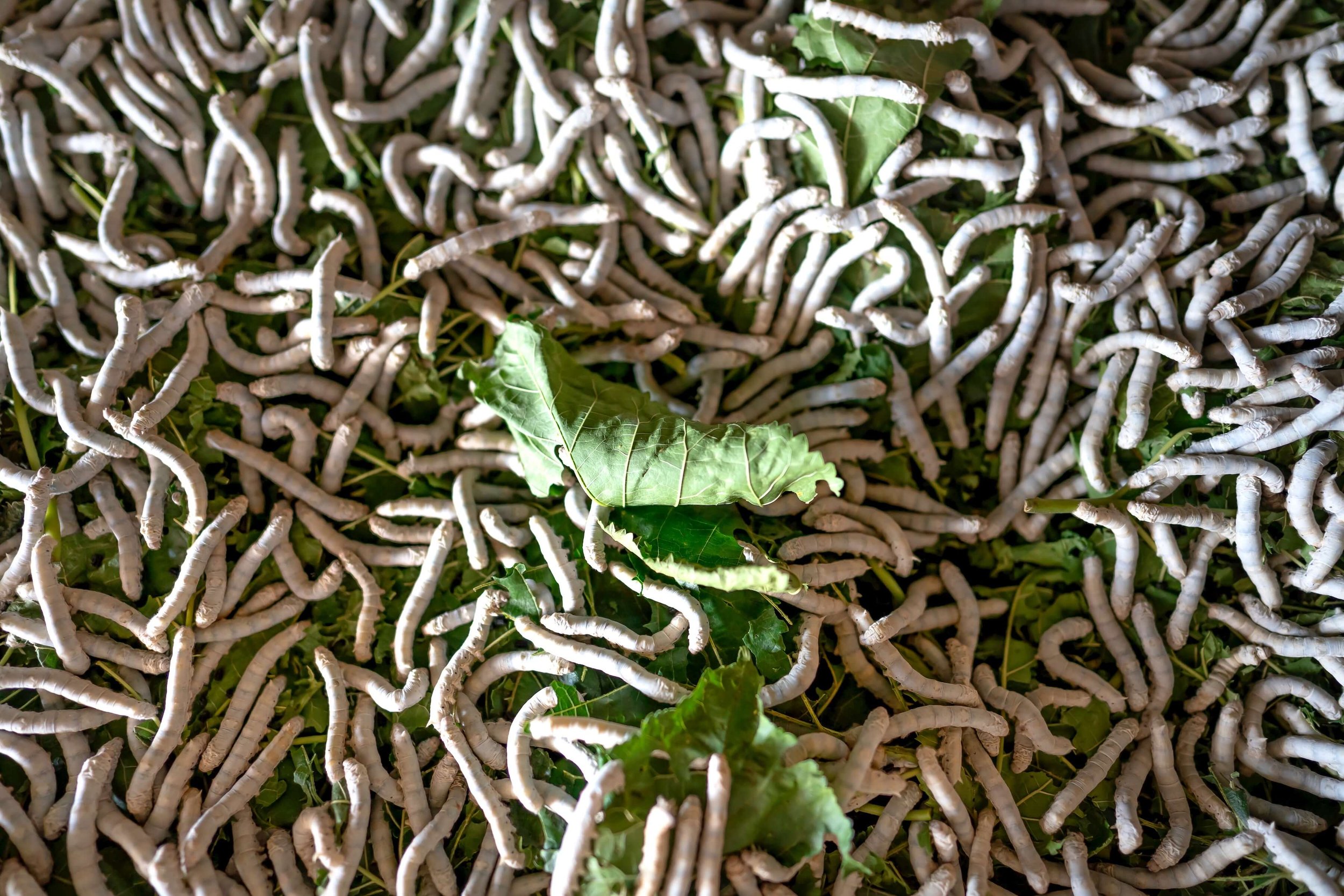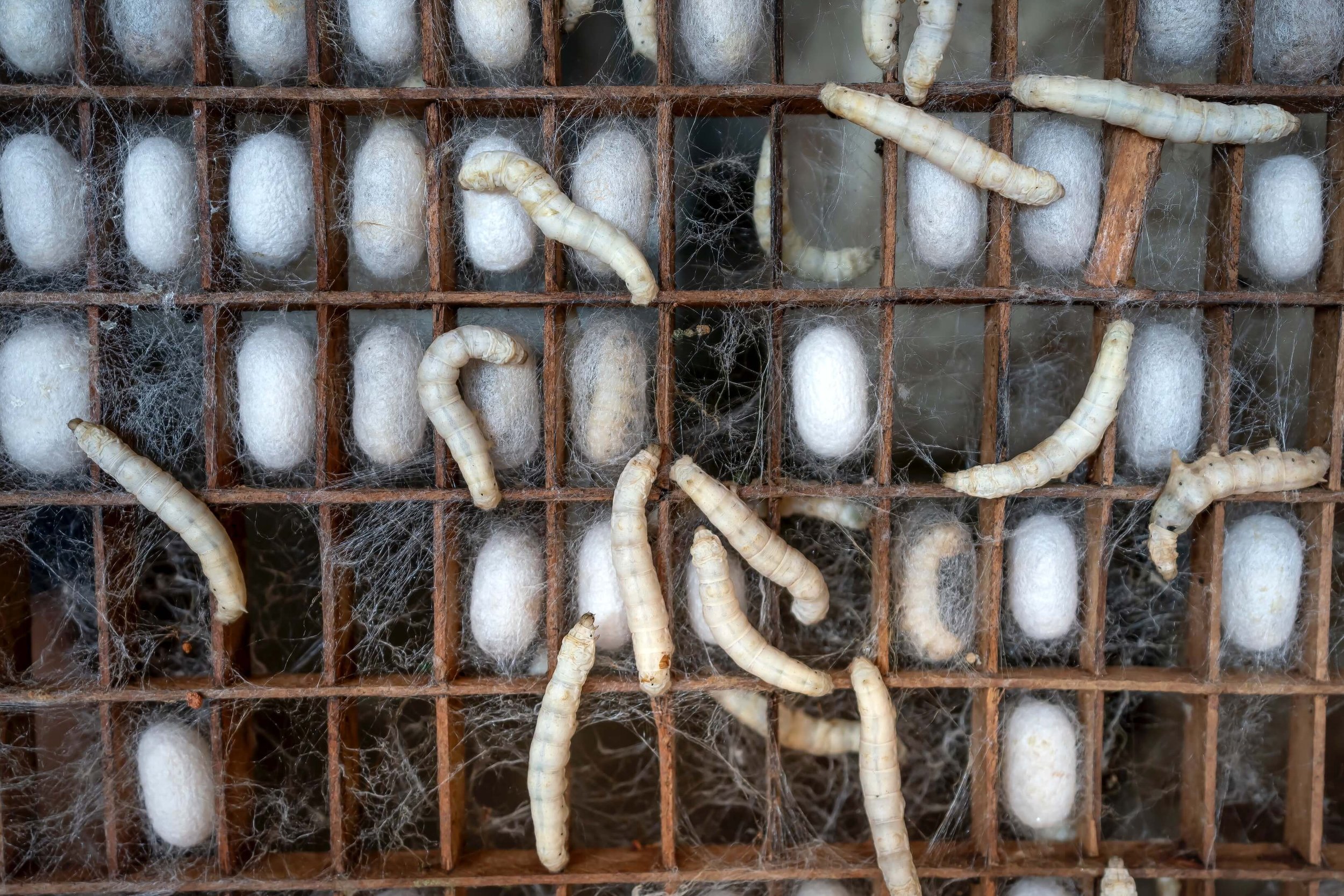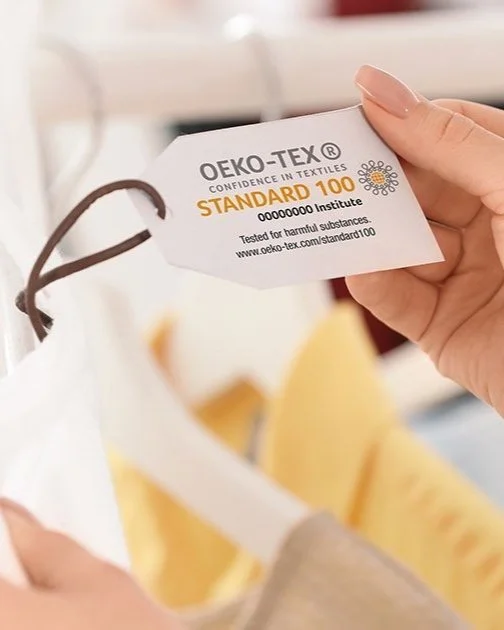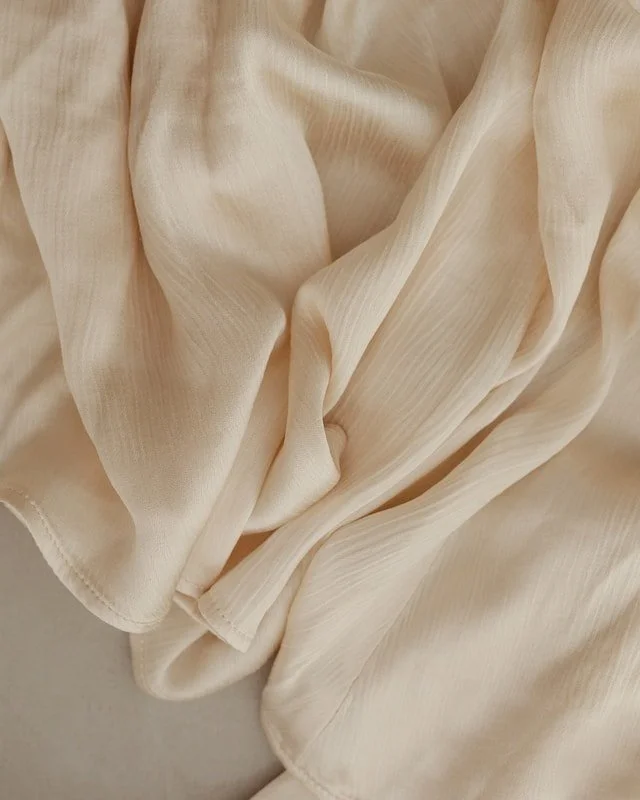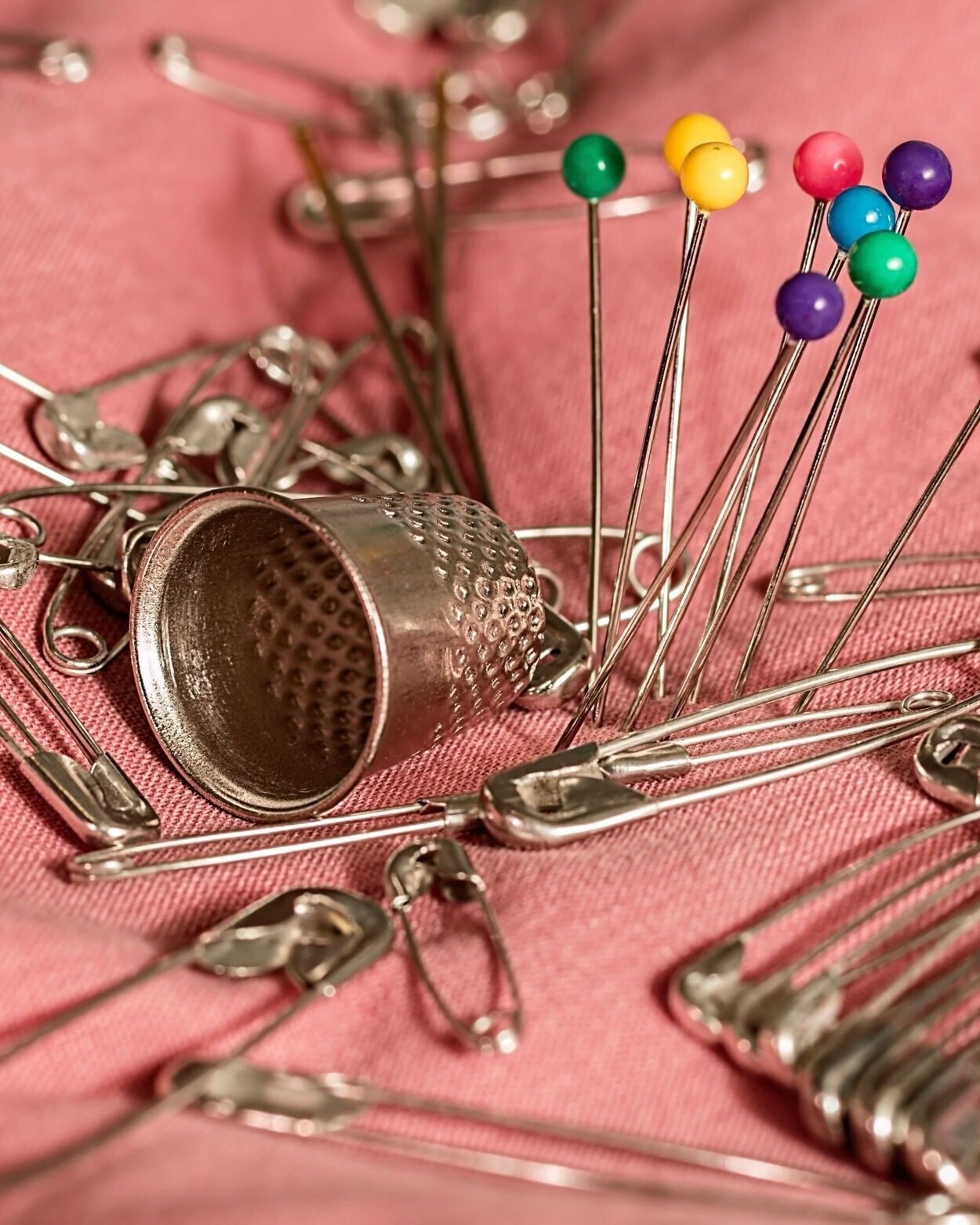Silk: How Ethical And Sustainable Is It? (& Better Alternatives To Choose Instead)
How Sustainable Is Silk? & Its Ethical Alternatives
Silk has been a highly demanded fabric for more than 5,000 years. It is delicate, lustrous and beautiful, and makes the perfect fabric for scarves, blouses and dresses.
A legend says that silk was discovered in 2640 BC by Chinese Empress Xi Ling Shi while drinking a cup of tea under a mulberry tree. A silkworm cocoon fell into her cup and, as it dissolved, the Empress understood that the cocoon was made of beautiful threads that could be used to create fine fabrics.
Silk has been produced since then, mainly in Asia, but sericulture became popular in the whole world as the centuries passed. Today, silk production accounts for less than 0.2% of the world’s fiber market, but it is a multi-billion dollar industry. ‘
Silk has unique properties, but it raises various ethical and sustainable issues. It’s also one of the most expensive fabrics, and owning silk clothing requires constant dry-cleaning.
So, should you invest in silk fabrics for your wardrobe? You’ll find out in this article! You’ll also learn about some more ethical and sustainable alternatives to choose instead.
WHAT IS SILK AND HOW IS IT MADE?
What is silk?
Silk is a natural fiber created by certain insects and arachnids to form their cocoons or webs, and it can be used to produce textiles.
In commercial applications, the most common silk is made with the filaments from the cocoons of the larvae of domesticated mulberry silkworms Bombyx mori. The silkworms are reared in captivity to create fabrics: this whole industry is called sericulture.
The production of silk is believed to have started in China during the Neolithic period, and it had played an essential role in the Chinese rural economy for millennia.
In the 2nd century AD, the practice was established in India, and as centuries passed, sericulture was exported to other parts of the world, especially the Middle East. Thanks to the Silk Road, it quickly reached the Mediterranean, and later, Western Europe where it flourished until the 19th century.
After the Second World War, nylon and other synthetic fabrics became popular and widely produced in the fashion industry, leading to the weakening of the silk industry. But silk did not disappear.
Nowadays, silk is used in various industries, the most common one being fashion. You can buy many clothing pieces made with silk, including blouses, shirts, lingerie, dresses and pajamas. Silk can also be found in home textiles like bedding, duvets, curtains and rugs.
It has many other industrial and commercial applications, and it’s used to make parachutes, bicycle tires and surgical sutures to name a few.
China is still by far the main silk producer, with around 60% of the world’s production.
How is it made?
Sericulture has existed for thousands of years, but it’s still a very labor-intensive process.
Silk production almost always involves rearing silkworms in captivity, and we usually use domesticated mulberry silkworms Bombyx mori.
It is possible to produce wild silk, using silkworms that live in the wild, like the tussah silkmoths. However, this type of production is a lot less predictable and more difficult, because the silk moths that are used cannot be domesticated.
The first step in the production process of conventional silk is to gather thousands of silkworms to harvest their cocoons. Female silk moths have around 300 to 500 eggs at once, and those eggs are incubated in a controlled environment until they become larvae.
Larvae are fed with mulberry leaves, and after six weeks, silkworms start spinning their cocoon by rotating their bodies around 300,000 times.
A silkworm needs three to eight days to create a single strand of silk that measures about 100 meters long. Around 2,500 silkworms are needed to create one pound of raw silk.
When all the silkworms have finished spinning their cocoons, silk producers place the cocoons in boiling water to dissolve the gum holding the cocoon together, killing the silkworm in the process. Each silk thread is then slowly reeled from the cocoon in individual threads and wound on a reel.
After being washed, degummed, bleached, and dried, silk threads are immersed in a dye bath to soak up a given color. Dyed silk threads are then spun onto a bobbin, and the weaving process can begin.
Two sets of threads are interlaced so that they lock around each other to form a durable fabric. Silk can be woven in various ways, which results in different finishes of the silk.
At this point, a pattern can be printed on the fabric, either using digital printing, or the more traditional screen printing method.
Finally, the silk fabric needs to be finished, which is usually done by using different chemical treatments that give the fabric specific properties, like crease-proofing and fire resistance.
The silk fabric can then be sewn and used to create all kinds of new products, including fashion pieces.
SHOULD YOU USE SILK?
How practical is silk clothing?
Silk has unique properties…
This fabric is lightweight and lustrous, and it has a soft feel. Its luminosity and sheen make it look luxurious, and it falls naturally, which is ideal for creating elegant clothing.
Silk is also a great material that takes well to dyes, meaning that you can usually find all kinds of colors when looking for silk clothing. In addition, it is very strong and doesn’t get damaged easily: one filament of silk is stronger than a comparable filament of steel!
Silk clothes are great to wear in the summer, as they keep you cool and can absorb a lot of moisture before feeling wet. In the winter, silk helps keep warm air close to the skin, making it a warm material that’s often used for its insulation properties.
All these great characteristics have made it a very demanded fabric throughout the world.
But it comes with its disadvantages…
One of the most significant disadvantages of silk is that it is more expensive than most other fabrics. As a result, silk clothes are often seen as a luxury that many people cannot afford.
It is also more challenging to take proper care of silk fabrics as it is recommended to dry-clean them. You might hand wash them, but you should first test for a color bleed on a small area on the inside.
Silk clothing shouldn’t go in the washing machine nor the dryer, which is inconvenient for many people. It also needs to be steam-ironed, but only on a low setting, and you shouldn’t put it in direct sunlight as it can fade easily.
If you aren’t careful with these recommendations, you risk damaging your silk fabrics.
How eco-friendly is silk?
The main environmental benefit of silk is that it is a durable, natural material, so it doesn’t shed microplastics into the environment while in the wash.
Untreated silk is also entirely biodegradable, even though chemicals, dyes and blended fabrics may hinder its biodegradability.
However, according to the Sustainable Apparel Coalition’s Higg Index, silk has a worse environmental impact than synthetic fabrics, and it has a huge global warming potential.
As a single mulberry tree feeds 100 silkworms, and we need 3,000 cocoons to create one yard of fabric, sericulture involves growing a huge quantity of mulberry trees. Even though fewer chemicals are sprayed on mulberry trees than other crops, like cotton, pesticides and fertilizers are usually used to grow them.
It contributes to the pollution of groundwaters and may cause serious environmental issues, such as eutrophication. Eutrophication leads to the spread of harmful algae in the environment and usually causes dead zones.
Silk production is also very energy and water-intensive. Boiling the water to cook the cocoons takes enormous amounts of energy and water. Temperature control in silkworm rearing facilities, transportation, dying and processing are other steps in the production process that require large amounts of energy. In addition, the silk is cleaned at different stages, which means that high volumes of water are used.
A lot of toxic chemicals, including dyes, are usually used during silk production, and untreated waters are regularly dumped into waterways.
Owning silk itself can be unsustainable as it requires dry cleaning, and dry cleaning solvents are very harmful to the environment.
How ethical is it?
One of the main reasons why sericulture is widely criticized is because it raises different ethical issues.
Conventional silk production involves boiling alive and killing the silkworms in their cocoons before they mature into moths. It is estimated that around 1,000 animals are killed to create a single silk shirt. Only a small percentage are allowed to mature, and they are used for reproduction purposes.
Once silkworms have mated, males are discarded, and females are crushed to death. Female silkworms are then checked under a microscope to make sure they are not sick. If a disease is detected, their eggs are destroyed as well.
Another ethical issue is that child labor is not uncommon in the silk industry. In 2003, the non-profit organization Human Rights Watch found that hundreds of thousands of children in India were working 12 or more hours per day, six to seven days a week. Some were as young as five years old!
Those children breathe toxic fumes and smoke daily, regularly have to dip their hands in boiling water, and are in contact with dead worms that can cause infections. They can easily get injured by other activities, cannot go to school, and are often beaten by their employers. There is no evidence that such practices have stopped since 2003.
Workers in the silk industry are also exposed to the chemicals that they are touching and breathing on a daily basis, at multiple stages during the production process. Those chemicals are very harmful to their health: they are linked to various diseases and deaths, and some of them are carcinogens.
A final point to consider is that almost all workers in the silk industry are located in low-income countries where workers are regularly exploited, paid unfair wages that aren’t enough to live, and offered inhumane working conditions.
MORE ETHICAL OR SUSTAINABLE ALTERNATIVES TO CONVENTIONAL SILK
Conventional silk production is not ethical nor sustainable. However, there are alternative ways to produce silk that are greener and more ethical and that you might prefer instead of buying conventional silk.
Peace silk
Peace silk, or Ahimsa silk, is the most common alternative to conventional silk. The main reason why this type of silk is "more ethical" is that moths are allowed to emerge and fly away before their cocoons are boiled safely. It means that no moth is boiled alive during the production process.
While peace silk is better than conventional silk, it still has a significant drawback to be aware of. After thousands of years of selective breeding, domesticated silkworms used in silk production are not "made" to live out of their cocoons.
They are unable to see and fly properly and cannot protect themselves from predators. As a result, they usually die quickly once they emerge from their cocoons.
So peace silk production is less cruel than conventional silk production, but it is still not ideal. It is also not much better in terms of environmental footprint.
Wild silk
Wild silk, or Tussar silk, is made from the cocoons of Tussar silkworms found in open forests. Their cocoons are usually harvested after the moths have emerged, making it a more ethical alternative to conventional silk.
Wild silkworms eat multiple types of plants, so they produce a less consistent fabric, but it's more durable. Fewer chemicals are also used to make the fabric.
However, some companies that use "wild silk" harvest the cocoons with the larvae still inside. So, while wild silk is supposed to be better for the silkworms, it is difficult to say whether all companies producing wild silk are truly waiting for silkworms to hatch and fly away.
Oeko-Tex or GOTS-certified organic silk
GOTS-certified organic silk is a more sustainable alternative to conventional silk. It is produced very similarly to conventional silk, but no pesticides or other harmful chemicals are used.
Everything in the production process is organic, and the silkworms get to eat a more varied diet instead of mulberry leaves alone.
Oeko-tex certified silk is another more sustainable option. It means that from raw materials to the end product, the silk is free of toxic chemicals, healthy and better for the environment.
However, whether you choose to buy Oeko-Tex or GOTS-certified silk, the silkworms are still killed before they have the chance to leave their cocoons. So organic silk is more eco-friendly but no more ethical than conventional silk.
Recycled silk
You cannot go wrong by choosing recycled silk! Used silk fabrics have been reused and recycled into new ones, and it is done without the ethical and sustainable issues of producing virgin silk. No additional silkworm is killed, and recycling a fabric also requires fewer resources to be used.
Vegan silk alternatives
If you're not comfortable wearing clothing made from animals, there are some vegan silk-like fabrics you may want to try.
Lotus silk is one of them: it is made by spinning the long roots of the lotus flower. Lotus plants are grown without pesticides and require very little water.
Other silk-like fabrics you can find are pineapple silk and banana silk. Both are made as a by-product of the fruit industry, so they're very sustainable fabrics, saving waste and resources.
Cactus silk is not to be ignored too! It is made using a subspecies of succulents that need very little water and no chemicals to grow.
The brand Bolt Threads also created "spider" silk. However, it is not made using spiders but by fermenting yeast, water and sugar, and it's very similar to real spider silk.
All these vegan alternatives are great options, and they're a lot more sustainable and ethical than conventional silk!
CONCLUSION
Thanks to its various characteristics, silk has been a highly demanded fabric for thousands of years.
However, conventional silk is not made ethically as it requires boiling live silkworms while still in their cocoons, and child labor is not uncommon in this industry.
It's also not sustainable because sericulture is very energy and water-intensive, and a lot of chemicals are added to the fabric.
Fortunately, there are more ethical or eco-friendly alternatives to conventional silk. They're not all perfect in terms of ethics or sustainability, but they're still better.
Recycled silk and vegan silk-like alternatives might be the most sustainable and ethical options.
About the Author:
Eva Astoul is a French freelance writer, specializing in content related to sustainability, simple living, and a growth-focused healthy lifestyle. She runs her own blog, Green With Less, to inspire people to live a more minimalist and sustainable life.
MAKE SURE TO PIN THE PHOTO BELOW TO SAVE THIS POST FOR LATER!
WANT MORE SUSTAINABLE BRANDS? VISIT OUR BRAND DIRECTORY!
Our Brand Directory is home to hundreds of sustainable brands, from makeup to cleaning supplies, from underwear to shoes. We have broken everything down by category for easy shopping, along with discount codes unique to Sustainably Chic viewers.


